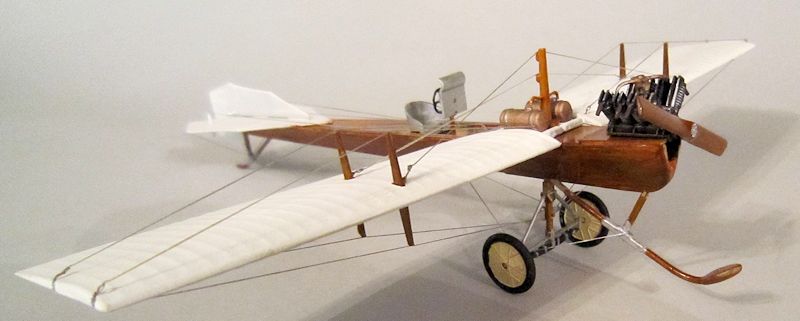
| KIT #: | P-102 |
| PRICE: | Second Hand £10 |
| DECALS: | Only for the stand |
| REVIEWER: | Chris Peachment |
| NOTES: |

| HISTORY |
This looks like the No 3 Martin-Handasyde an early British single-seat monoplane
design, built by the partners HP
Martin an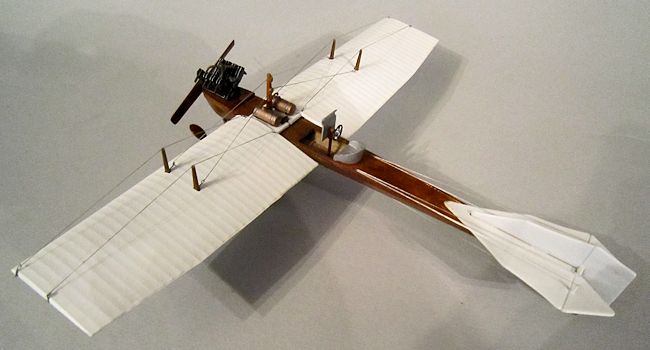 d George Handasyde. Only one was built, and it bore a close resemblance
to Antoinette monoplanes of that period, with its thin wooden triangular section
fuselage, and tapered wings braced by mid-span kingposts. Lateral control was by
wing warping, though it had a conventional tailplane with rudder and elevators.
The undercarriage was a cross-axle with a leaf spring and a curved skid ahead.
It was powered by a 60hp Antoinette V-8 engine. It was first flown at Brooklands
by HP Martin in 1910, and was then flown throughout 1912 by G Gilmour who was
killed when it suffered a mid-air structural collapse in February 1912. After
this, the Martin Handasyde team concentrated, perhaps wisely, on motorcycles
with the name Martinsyde.
d George Handasyde. Only one was built, and it bore a close resemblance
to Antoinette monoplanes of that period, with its thin wooden triangular section
fuselage, and tapered wings braced by mid-span kingposts. Lateral control was by
wing warping, though it had a conventional tailplane with rudder and elevators.
The undercarriage was a cross-axle with a leaf spring and a curved skid ahead.
It was powered by a 60hp Antoinette V-8 engine. It was first flown at Brooklands
by HP Martin in 1910, and was then flown throughout 1912 by G Gilmour who was
killed when it suffered a mid-air structural collapse in February 1912. After
this, the Martin Handasyde team concentrated, perhaps wisely, on motorcycles
with the name Martinsyde.
| THE KIT |
I found this second hand under a table at an IPMS model meeting at RAF Hendon in
North London. The kit was made in London, dates from some time in 1960s, and is
straightforward and presents no large problems in construction. The plastic is
tan and medium soft and has little flash and few moulding seams.
No etched parts, the only additions being a reel of black thread for rigging, and a clear stand.
| CONSTRUCTION |
For once, construction did not begin with the interior, as there isn't any to
speak of. Once the cockpit floor is wedged into the lower V-shape fuselage, then
the top deck can be fitted, along with the forward engine mount. Wings and
tailplane are best kept separate and given a coat of white. (See below.) The
engine was p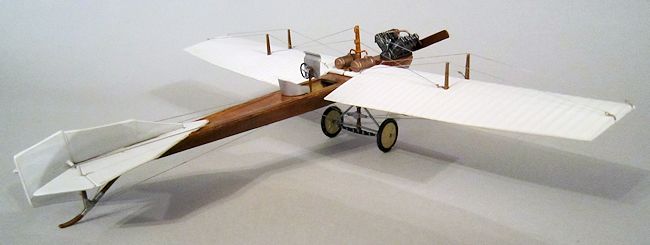 ut together from 5 parts, painted and fixed to its mount. The
forward control mast was fitted, together with joystick and wheel, and pilot's
seat. I have no figure painting skills, so didn't use the pilot figure, who is
jauntily dressed in Edwardian sporting gear of tweed jacket, roll neck sweater
and a flat cap. He has a separate arm to attach to the control wheel. If you can
paint figures, it might be nice to use him, to give a sense of scale and also
period. I also fitted the one piece beam axle undercarriage, the forward
spoon-shaped skid, and tailskid. All of this was then painted to represent wood
(see below). The kingposts can be painted wood, then slid through their holes
mid-wing and glued. The two fuel tanks were painted and fixed into the wing
roots, and the wings and tailplane then fitted. All the mounting holes and tabs
proved well designed and strong.
ut together from 5 parts, painted and fixed to its mount. The
forward control mast was fitted, together with joystick and wheel, and pilot's
seat. I have no figure painting skills, so didn't use the pilot figure, who is
jauntily dressed in Edwardian sporting gear of tweed jacket, roll neck sweater
and a flat cap. He has a separate arm to attach to the control wheel. If you can
paint figures, it might be nice to use him, to give a sense of scale and also
period. I also fitted the one piece beam axle undercarriage, the forward
spoon-shaped skid, and tailskid. All of this was then painted to represent wood
(see below). The kingposts can be painted wood, then slid through their holes
mid-wing and glued. The two fuel tanks were painted and fixed into the wing
roots, and the wings and tailplane then fitted. All the mounting holes and tabs
proved well designed and strong.
For control lines I used elastic thread which had been pre-coloured silver from
a felt tip marker, and secured in place using a tiny drop of superglue gel,
placed with a sharpened toothpick. The elevator and rudder lines emerge from two
holes behind the front cockpit. The wing warping wires run from the wing tips
over the kingposts to the central control post. I fashioned anchor points from
fuse wire, twisted around a drill bit to form a short post with a loop at the
top. The posts were superglued in place and the loops bent to the correct angle.
The silver threads can then be slipped in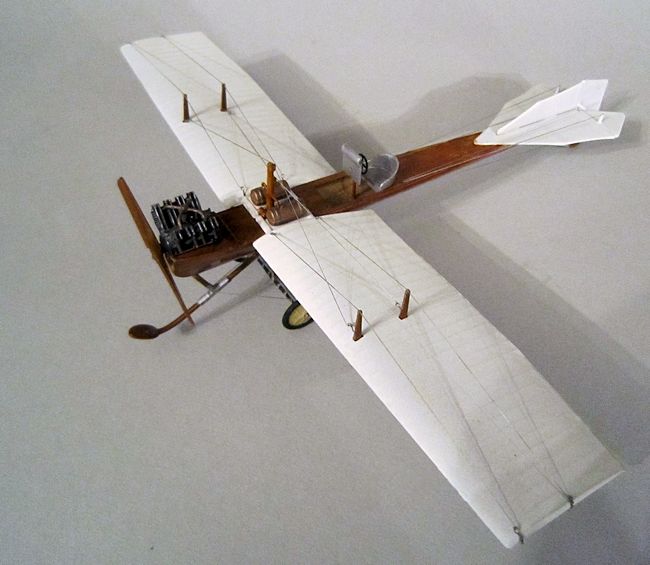 to the loop and superglued in place
with a small drop of gel on a toothpick. A new scalpel blade trims them off.
The prop, painted as wood, was added and the solid metal windscreen glued
in place on the control column.
to the loop and superglued in place
with a small drop of gel on a toothpick. A new scalpel blade trims them off.
The prop, painted as wood, was added and the solid metal windscreen glued
in place on the control column.
And finally, to the shame and humiliation of the kit and its makers, the wheels
were added. And I didn't glue them in place because they are an unsightly
disgrace and I don't know what to do about them. Clear plastic just won't do to
represent spoked wheels. I have scratch built spoked wheels in the past for
Merit Racing cars of the 50s, but these ones are too small for my ageing fingers
and eyes. I have used photo-etched spokes on a 1/48 Lebed biplane by Special
Hobby, but wasn't entirely happy with them, as it is tricky to get them dished
to the right conical shape. And the spokes themselves are flat rather than
circular in cross section. Besides I have none in my spares box. I cannot find
any after-market spoked wheels. If any kind reader can suggest a solution, I
would be more than grateful. Indeed I won't be happy until I have binned those
wheels and found a substitute. I painted over the hubs in linen colour, and
tried to pretend that they were canvas covered. But a larger part of me knows
that was not the case with the original. In the meantime, please avert your
gaze.
The small reel of black cotton thread is best consigned to the spares box until you get around to rigging a three masted schooner.
| COLORS & MARKINGS |
There are no markings. Wings and tailplane were painted separately with Humbrol
Primer White from a rattle can, and very good paint it is too, showing no signs
of pooling or running but giving an even,
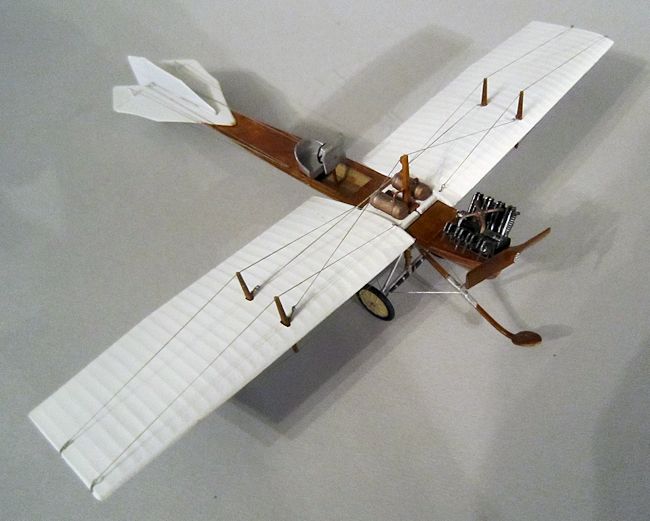 solid white finish.
solid white finish.
For the fuselage and undercarriage parts, I chose my usual way of doing wood,
which is to paint an undercoat of middling brown, in this case Middle Stone from
the Lifecolor range, and then giving it a streaky dry brushing of UK Dark Earth
(Lifecolor again) with a stiff hog-bristle brush. This is then coated with
Tamiya Clear Orange, and given a very light wet and dry sanding to tone down the
gloss a little, though not too much.
The engine was painted matt black with a dry brushing of gunmetal, and the
intake tubes on top were painted bronze, and dirtied with matt black. The
exhaust stubs were picked out in dark rust.
That windscreen, which was as much to protect the pilot from oil spillage as
from the slipstream, was painted matt silver (Xtracrylix RLM 01)
| CONCLUSIONS |
I built this kit when it first came out, back in the 60s, in the wake of seeing
the film Those Magnificent Men... and had very fond memories of it. As I do also
of that film, which never seems to be re-released here in the UK, though I
believe there is a DVD available. It was very pleasing to find it again, and
have those memories confirmed: that it is an excellent little kit depicting an
aircraft from a period which is sadly neglected by kit manufacturers.
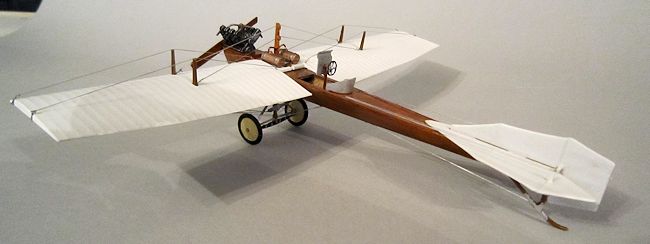 On a different note, I can't help noticing how modern the aircraft is. It has
excellent all round vision for the pilot, probably better than any modern
fighter even the F-16. It has an armoured windscreen. And has anyone noticed how
modern aircraft mimic the old wing-warping method of control? When you see the
variable-angle flaps and slots and slats all come down during the landing
approach of your modern airliner, have you ever realised that they are doing
exactly the same as wing-warping and varying the camber of the wing?
On a different note, I can't help noticing how modern the aircraft is. It has
excellent all round vision for the pilot, probably better than any modern
fighter even the F-16. It has an armoured windscreen. And has anyone noticed how
modern aircraft mimic the old wing-warping method of control? When you see the
variable-angle flaps and slots and slats all come down during the landing
approach of your modern airliner, have you ever realised that they are doing
exactly the same as wing-warping and varying the camber of the wing?
I see from the Lindberg website that they have plans to re-release the Bristol
Boxkite and the Avro Triplane. I will certainly get these kits when they appear,
and hope for the rest of the range of six, which included a Belriot, a
Deperdussin, and an Avro Biplane. And also hope that they do something about
those spoked wheels. If they don't then at perhaps there will be an opportunity
for the aftermarket companies to make some spoked wheels.
| REFERENCES |
Obviously there are no surviving examples of this early aircraft.
But pictures of the aircraft can be found as follows.
flyingmachines.ru/Site2/Crafts/Craft28538.htm
http://www.flightglobal.com/pdfarchive/view/1913/1913%20-%200007.html
http://en.wikipedia.org/wiki/Martinsyde
February 2014
Copyright ModelingMadness.com. All rights reserved. No reproduction in part or in whole without express permission from the editor. If you would like your product reviewed fairly and fairly quickly, please
contact the editor or see other details in the
Note to
Contributors.